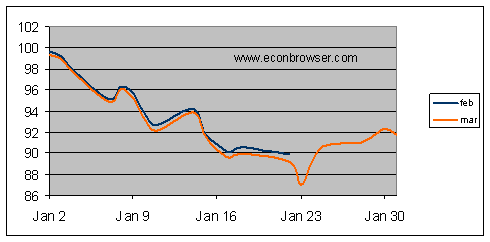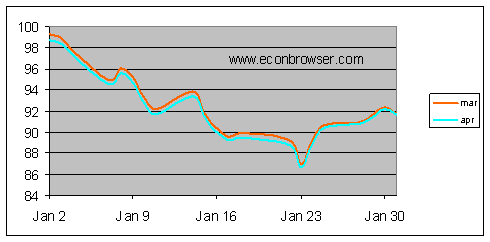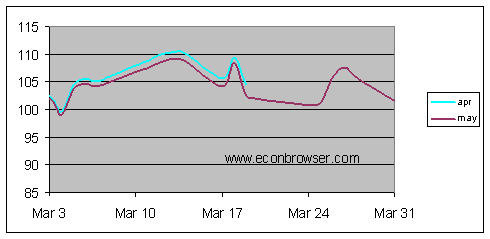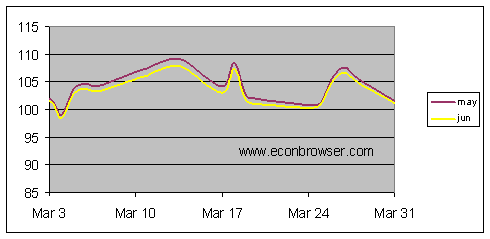The Commodity Futures Trading Commission on Tuesday filed a civil enforcement action alleging that Nicholas Wildgoose and James Dyer, who worked as traders for Arcadia Petroleum Ltd. and its affiliates, profited by manipulating the price of oil and oil futures in early 2008. I was interested to take a look at the details of the CFTC allegations.
Let me begin by providing a little background. Cushing, Oklahoma has an important network of pipelines and storage facilities that allow it to serve as a major trading hub for crude oil. There exists a physical market in which you can arrange to buy or sell oil for delivery in Cushing. Yesterday (the 25th calendar day of May) was the last day you could have scheduled a pipeline to deliver physical oil to Cushing some time in June. Economists might describe an agreement reached in May to receive oil some time in June as a forward contract.
There are also separate arrangements known as futures contracts, such as the well-known light sweet crude contract traded on NYMEX. Whereas a forward contract is an agreement between two particular parties accompanied by a stand-by letter of credit from a bank ensuring the buyer’s ability to pay, a futures contract is intermediated by an exchange that insists on maintenance of a continually adjusted margin account, creating the possibility for an anonymous, purely financial transaction. Many of the people who buy futures contracts do not want to receive physical oil in Cushing, but instead intend from the beginning to later sell the contract to somebody else in order to reap a financial gain if the price goes up, as a way to hedge against certain risks. For example, a refiner, even if not located in Cushing, might buy (and later sell) a NYMEX futures contract as a form of insurance against an increase in the price of oil during the time the contract is held. Alternatively, a pension fund might want to buy (and later sell) a futures contract in order to have some insurance against inflation or commodity price moves that could adversely affect other holdings in its portfolio. Other people might be interested in a futures contract because they have a particular belief about the direction that oil prices will head. If someone buys a futures contract and at some later date sells the same contract, the futures exchange nets out those transactions, so much of the time when two parties enter into a futures contract, no oil ends up being physically delivered to anybody.
But if you buy a futures contract and never sell it, a NYMEX contract entitles you to receive delivery of 1000 barrels of physical oil at Cushing, Oklahoma some time in the month specified by the contract. Trading in the June NYMEX futures contract ended on May 20, three business days before the last day of pipeline scheduling on the 25th, to allow parties who held on to their futures contract all the way to expiry 3 days in which to schedule a date in June for physical delivery to Cushing.
The CFTC complaint alleges that between January 8 and January 18 of 2008, oil traders Nicholas Wildgoose and James Dyer entered into forward contracts to buy 4.6 million barrels of oil for physical delivery in February, an amount that represented 66% of their beginning-of-month estimate of the total physical Cushing market. Between January 3 and January 16, the pair is alleged to have also bought about 13,600 February futures contracts (equivalent to 13.6 million barrels of oil) and sold the same number of March futures contracts. The claim is that by creating the appearance of temporarily tighter conditions in the physical market, the February futures price would rise relative to the March and the traders would profit as they closed out their futures positions between January 16 and January 22.
The graph below plots the prices of the February and March NYMEX futures contracts during the month of January 2008. Note that the CFTC is not alleging that these actions were a cause of rising oil prices– in fact, the price of oil was falling during this period. Rather, the allegation is that these actions resulted in an increase in the spread between the February and March futures price, that is, in the absence of these actions, the February price would have fallen more and the March price would have fallen less.

Price of February and March NYMEX light sweet crude oil futures during the month of January 2008
The CFTC complaint alleges that Wildgoose and Dyer subsequently acquired by January 25 a net short position in March futures and long position in April futures equivalent to 12.2 million barrels. The allegation is that this was done in anticipation of suddenly selling off on the last possible day (Jan 25) all 4.6 million barrels of the physical oil previously accumulated; I gather that the allegation is that this was achieved by finding somebody currently holding rights to delivery of an equivalent volume in March who was willing to swap and take delivery instead in February, provided that the offered February price was sufficiently low. The effect of such a huge last-day sale would have been to depress the February physical price as the market discovered that the apparent big demand for oil just wasn’t there. Although Wildgoose and Dyer would of course have taken a big loss on their physical contracts (by virtue of having bought at the artificially higher prices that their bids created and then selling at the artificially lower prices that their sales induced), the CFTC alleges that they more than made up for these losses with bigger profits on the corresponding futures transactions. The CFTC complaint alleges that the pair lost $15 million on the physical transactions but gained $50 million on futures transactions, profiting first by the increase in the February-March spread induced by creating the impression of an unusually tight February physical market, and then later profiting by the decrease in the March-April spread by surprising the market with much more physical oil available for delivery than people had been assuming.

Price of March and April NYMEX light sweet crude oil futures during the month of January 2008
The CFTC complaint goes on to allege that the pair repeated the same sequence of transactions in March of 2008– initially profiting from a long position on the April-May spread by surprising the market by buying a large quantity of physical oil for April delivery in the first part of the month, and then profiting from a short position on the May-June spread by surprising the market by selling off their physical positions on the last possible day.

Price of April and May NYMEX light sweet crude oil futures during the month of March 2008
Again, March 2008 was not a month in which the oil price overall is alleged to have been driven up as a result of the traders’ actions. Instead, the claim is that their actions led to an initial increase in the April-May spread and a subsequent decrease in the May-June spread.

Price of May and June NYMEX light sweet crude oil futures during the month of March 2008
Arcadia Petroleum Ltd. has said the CFTC charges are “completely without merit”.
- Bulenox: Get 45% to 91% OFF ... Use Discount Code: UNO
- Risk Our Money Not Yours | Get 50% to 90% OFF ... Use Discount Code: MMBVBKSM
Disclaimer: This page contains affiliate links. If you choose to make a purchase after clicking a link, we may receive a commission at no additional cost to you. Thank you for your support!



Leave a Reply